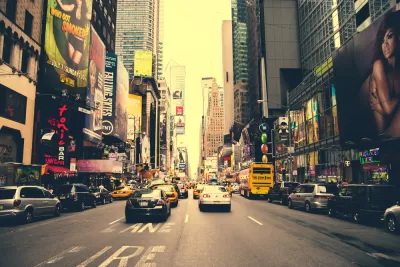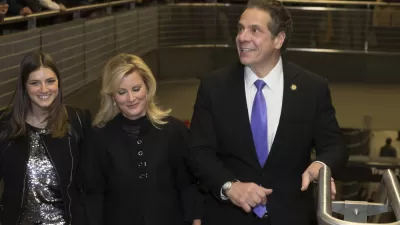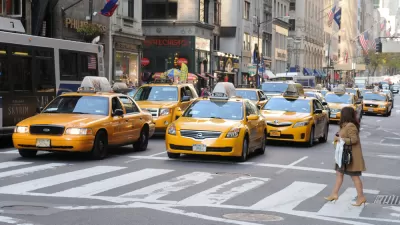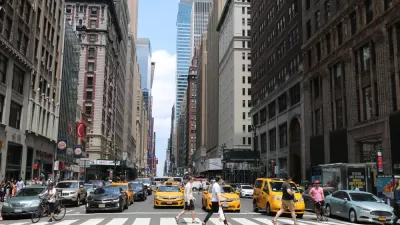Ten years after former NYC Mayor Michael Bloomberg's congestion pricing plan died on the state Assembly floor, expect to see a similar plan revived by Gov. Andrew Cuomo (D-N.Y.). New York Times metro reporter, Winnie Hu, explains why it never died.

"For decades, urban planners, economists, city officials and business leaders have revived again and again some version of a toll system both to manage the city’s worsening traffic and provide more revenue for public transit, writes Winnie Hu, a reporter on The New York Times Metro desk, focusing on transportation and infrastructure.
Now a state task force, called Fix NYC, has been assembled with the goal of developing another congestion pricing plan.[...]. Mr. Cuomo, after once expressing doubt about congestion pricing’s chances, is expected to unveil a plan early next year and make it a centerpiece of his legislative agenda.
Hu chronicles the movement to keep congestion pricing (also known as cordon pricing because tolls would apply toward a specific area, below 60th Street in Manhattan, much like London, Stockholm and the world's first scheme in Singapore) alive after former Mayor Michael R. Bloomberg's bill died in Albany after state legislative leaders refused to bring it to a vote (also posted here).
Congestion pricing “never really went away” said Mitchell L. Moss, the director of the Rudin Center for Transportation Policy and Management at New York University, noting that “it has an intrinsic appeal — a single solution that raises revenue, improves our environment and reduces congestion.”
Central to the effort were three congestion pricing advocates: Sam Schwartz, Charles Komanoff and Alex Matthiessen, brought together by transit advocate, Theodore W. Kheel, a prominent lawyer and labor arbitrator, to work on the issue. Kheel passed away two years after Bloomberg's bill died.
The three continued to promote Bloomberg's plan under the group, Move NY, but made some significant changes, like lowering tolls on some bridges while adding tolls to the untolled East River bridges, a key part of the plan. Funding was provided by The Rockefeller Foundation and the Nurture Nature Foundation, which was founded by Mr. Kheel.
Timing is right in 2017
This year, the state of decay of the New York subway became really evident. In June, Gov. Cuomo declared a "state of emergency" for the subway. [See Nov. 18 update by Brian M. Rosenthal, Emma G. Fitzsimmons and Michael Laforgia in the Times]. It was painfully clear that the subway needed modernization funds.
Also this year, Cuomo, a "car guy", took notice of improvements in bridge tolling technology. Having recently celebrated the opening of the long-stalled replacement of the Tappan Zee bridge, he recognized the benefits of electronic toll technology which enable toll collection via E-ZPass transponders and vehicle license-plate recognition, eliminating the congestion caused by the presence of toll booths. Cuomo was on-board.
Challenges ahead
Before the congestion plan gets to be debated in Albany, presumably it has to pass the New York City Council, as its predecessor did on March 31, 2008, and be signed by Mayor Bill de Blasio, an opponent, who doesn't believe it is fair. Rather than charging drivers to enter Manhattan, he wants to pursue "a tax on wealthy New Yorkers to pay for improvements needed to address the crisis engulfing New York City’s subway," reported Emma G. Fitzsimmons on Aug. 6 for the Times.
"Asked what aspects of congestion pricing the mayor does not believe in, a spokesman for Mr. de Blasio returned to the idea of a new tax to fund transportation," reported David Goodman on Aug. 21 for the Times.
“It’s not a secret that the wealthiest among us aren’t paying their fair share,” said the spokesman, Austin Finan, in a statement. “If the governor disagrees, he should submit his own plan and we’ll evaluate it on the merits, including fairness and equity.”
Look for that plan next month.
FULL STORY: New York’s Tilt Toward Congestion Pricing Was Years in the Making

Study: Maui’s Plan to Convert Vacation Rentals to Long-Term Housing Could Cause Nearly $1 Billion Economic Loss
The plan would reduce visitor accommodation by 25,% resulting in 1,900 jobs lost.

Alabama: Trump Terminates Settlements for Black Communities Harmed By Raw Sewage
Trump deemed the landmark civil rights agreement “illegal DEI and environmental justice policy.”

Why Should We Subsidize Public Transportation?
Many public transit agencies face financial stress due to rising costs, declining fare revenue, and declining subsidies. Transit advocates must provide a strong business case for increasing public transit funding.

Paris Bike Boom Leads to Steep Drop in Air Pollution
The French city’s air quality has improved dramatically in the past 20 years, coinciding with a growth in cycling.

Why Housing Costs More to Build in California Than in Texas
Hard costs like labor and materials combined with ‘soft’ costs such as permitting make building in the San Francisco Bay Area almost three times as costly as in Texas cities.

San Diego County Sees a Rise in Urban Coyotes
San Diego County experiences a rise in urban coyotes, as sightings become prevalent throughout its urban neighbourhoods and surrounding areas.
Urban Design for Planners 1: Software Tools
This six-course series explores essential urban design concepts using open source software and equips planners with the tools they need to participate fully in the urban design process.
Planning for Universal Design
Learn the tools for implementing Universal Design in planning regulations.
Smith Gee Studio
Alamo Area Metropolitan Planning Organization
City of Santa Clarita
Institute for Housing and Urban Development Studies (IHS)
City of Grandview
Harvard GSD Executive Education
Toledo-Lucas County Plan Commissions
Salt Lake City
NYU Wagner Graduate School of Public Service





























